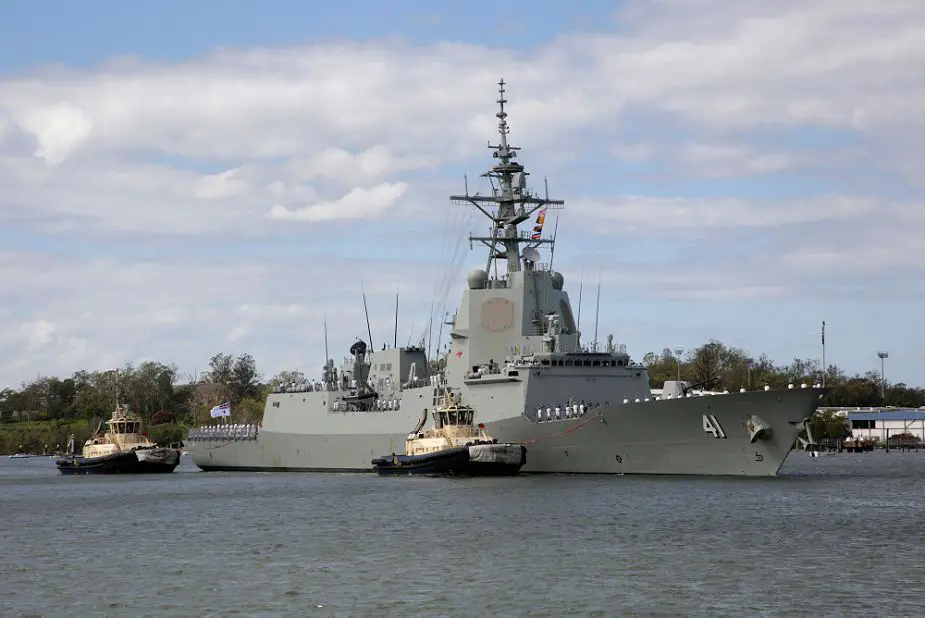Royal Australian Navy and the United States Navy, HMAS Brisbane missile destroyer of the Australian Navy has completed a live missile engagement. Using remote sensor data from the USS Stockdale Arleigh Burke-class guided missile destroyer of U.S. Navy and the Cooperative Engagement Capability, the combat system was tested against a range of challenging targets and tactical situations.
Royal Australian Navy and the United States Navy, HMAS Brisbane missile destroyer of the Australian Navy has completed a live missile engagement. Using remote sensor data from the USS Stockdale Arleigh Burke-class guided missile destroyer of U.S. Navy and the Cooperative Engagement Capability, the combat system was tested against a range of challenging targets and tactical situations.
 Royal Australian Navy Guided Missile Destroyer HMAS Brisbane (III) is moved into position by tugboats during its docking at Hamilton wharf on its first visit to Brisbane.(Picture source Australian Navy)
Royal Australian Navy Guided Missile Destroyer HMAS Brisbane (III) is moved into position by tugboats during its docking at Hamilton wharf on its first visit to Brisbane.(Picture source Australian Navy)
Australian Minister for Defence, Senator the Hon Linda Reynolds CSC said the trials which were held in the US over the past month, mark a ground-breaking milestone for Australia.
“This missile firing demonstrates the very highest levels of interoperability between our navies,” Minister Reynolds said.
“It reaffirms the game changing technology that the Aegis combat system brings to our Navy and the advanced capability of the Australian-built Hobart Class Destroyers.
“By conducting these trials in the US, our Navy is able to access the world’s best expertise, instrumented ranges and analysis capabilities to provide confidence in how the ship will perform in combat.”
HMAS Brisbane (III) is the second of three ships of the Hobart Class guided missile destroyers. Her sister ships are HMAS Hobart (III) and NUSHIP Sydney (V). The keel of Brisbane was laid down on 3 February 2014 and was launched by Mrs Robyn Shackleton on 15 December 2016. HMAS Brisbane commissioned on 27 October 2018. HMAS Brisbane is based on the Navantia designed F100 frigate and is coupled it with the Aegis Combat System.
The Hobart class is an air warfare destroyers (AWDs) being built for the Royal Australian Navy (RAN). Planning for ships to replace the Adelaide-class frigates and restore the capability last exhibited by the Perth-class destroyers began by 2000, initially under acquisition project SEA 1400, which was redesignated SEA 4000.
The Hobart class missile destroyer a length overall of 147.2 metres, a maximum beam of 18.6 metres, and a draught of 5.17 metres . At launch, the ships will have a full-load displacement of 6,250 tonnes (6,150 long tons; 6,890 short tons).
Main weapon of Hobart class missile destroyer includes a 48-cell Mark 41 Vertical Launch System. The cells are capable of firing the RIM-66 Standard 2 anti-aircraft missile or the quad-packed RIM-162 Evolved Sea Sparrow point-defence missile. The Force 2030 white paper indicates that the Hobart's Mark 41 launchers are likely to be capable (either as built or through later modification) of firing the RIM-174 Standard 6 anti-aircraft missile and the Tomahawk cruise missile.[17]
The missiles are supplemented by two four-canister launchers for Harpoon anti-ship missiles and a BAE Systems Mark 45 (Mod 4) 5-inch gun with a 62-calibre barrel. The 5-inch gun has a maximum range of 23.6 kilometres. Two Babcock Mark 32 Mod 9 two-tube torpedo launchers will be carried and used to fire Eurotorp MU90 torpedoes at submarines. For close-in defence, the ships will carry an aft-facing Phalanx CIWS system, plus two M242 Bushmasters in Typhoon mounts sited on the bridge wings.
The Hobart class missile destroyer has a crew of 186 sailors, plus 16 additional personnel to operate and maintain the ship's helicopter. Additional accommodation increases the maximum potential complement to 31 officers and 203 sailors.







